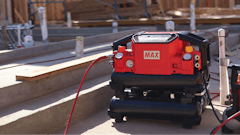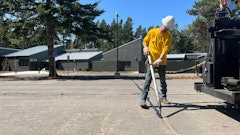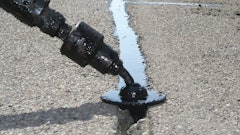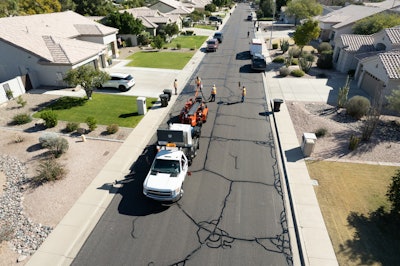
Content Sponsored by Crafco
In most areas of the country, the end of the season is an extremely busy time. Contractors are trying to squeeze in every job they can before winter hits and they can no longer complete work. As the temperatures start to drop however, the number of sales you make should rise as pavement owners need to be repairing cracks before the damaging winter months.
Start with Sales
In the spring, customer purchases tend to be driven by opportunity, while fall purchases can more likely be driven by risk.
Sales Tip: Fall pavement repair sales should more be pitched as preventative; “you need this service to reduce the risk of loss/liability through the coming winter months.”
Research shows that spending $1 on preventative pavement maintenance today averts $6 to $14 of cost later. Be an advocate of pavement maintenance to your customer, especially in the fall. Crack sealing and sealcoating are essential to pavement health and far less expensive than new construction once pavement is irreparable.
Your customers should understand that crack sealing is a preventative measure that will waterproof cracks and help protect the pavement from precipitation and the freeze/thaw cycles winter will bring. Winter freeze-thaw cycles cause cracks to expand and become bigger problems. Stop potholes before they happen by crack sealing to prevent water from seeping into the pavement.
Educate your salesforce and therefore your customers on what this looks like:
Should cracks in the pavement be left untreated before winter, they could turn into potholes through the perils of the winter months.
Moisture that worked its way into those cracks saturated the subgrade. When that material freezes, the area expands.
This pushes the pavement surface up, weakening it. Then, once temperatures rise in the spring, the frozen material contracts, leaving space under the pavement surface.
That weakened surface is now left unsupported. Once traffic hits that spot, the cavity that was created will collapse and you have yourself a shiny new pothole.
That spot must now be fully repaired or it will continue to expand.
Not repairing problems in pavement can lead to premature wear of that pavement’s life or worse, catastrophic damage can be done to the integrity of your pavement if water is allowed to continually seep in. The saying goes, “fix the roof now so that you don’t have to fix the house later.”
Proper Fall Crack Repair
In the cold temperatures of winter, pavement contracts and cracks open to their widest. In the hot summer season, the pavement expands and closes the cracks. During spring and fall, cracks are open midway and this is why those seasons are considered optimal times for crack repair.
Even though the cooler temperatures in the fall are ideal for this service, contractors must be sure crack repair operations are only done in dry conditions. Any moisture that’s present in the pavement can decrease effectiveness of the seal or create frost action in colder temperatures which will render the seal ineffective.
During crack repair, specialized materials are used that bond to the walls of the crack, preventing intrusion of water and incompressible materials into the crack, and moving with the pavement as it expands and contracts. Crack sealant is specifically engineered to use specialized materials that allow it to remain flexible at low temperatures so it doesn’t crack or split open, and it remains stable at higher temperatures so that it doesn’t track or bleed on the pavement.
Crack sealing operations consist of these steps:
1. Crack Routing
Crack routing, or cutting, is done prior to crack sealing to clean the crack. This creates fresh edges to allow sealant to adhere better and a designed reservoir to allow sealant to accommodate pavement expansion and contraction with seasonal temperature changes.
2. Crack Cleaning and Drying
As mentioned above, it is essential to provide a clean, dry crack channel and remove any loose material from the crack as sealant failure is caused by adhesion failure with the crack wall.
3. Material Preparation
Contractors should follow manufacturers’ application temperature ranges, heating temperatures and recommended moisture conditions prior to application.
4. Material Placement
Be sure the sealing operation moves at a steady pace. The kettle operator should monitor the temperature and quantity of material as over or under heating the material can suspend the entire operation. It is recommended that material be added equal to the amount of material being placed during crack sealing operations to maintain appropriate application temperature range.
5. Blotting
Blotting protects the uncured crack treatment from tracking under traffic and is used in areas where traffic needs to travel on the material before it cures. Proprietary detackifying products are available that are designed specifically for blotting crack sealant.
As with any project your company completes, make sure you have the proper materials and equipment that will provide support in the field. Smart planning along with these tips will ensure simple, effective crack sealing and great pavement performance, keeping your customers happy for years to come.



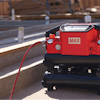
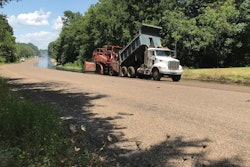

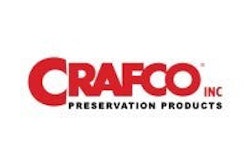
![Cemen Tech C60 5acd09ba7630e[1]](https://img.forconstructionpros.com/files/base/acbm/fcp/image/2022/03/Cemen_Tech_C60.5acd09ba7630e_1_.623c916eea2d7.png?auto=format%2Ccompress&fit=crop&h=167&q=70&rect=105%2C174%2C1725%2C969&w=250)



